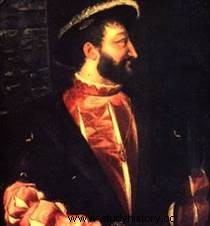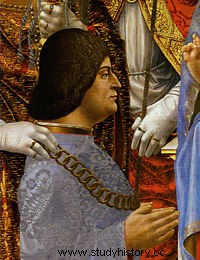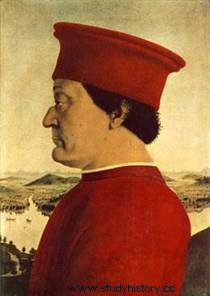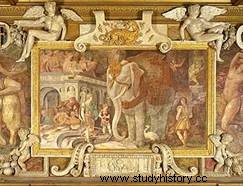 Francis I is the monarch who most often embodies the model of the Renaissance prince . If the latter marks the transition between the Middle Ages and the so-called “modern” era, it is however more attached to the artistic field than to politics. However, it also marks an evolution between the prince of the Middle Ages and that of the modern era, between the end of the 15th and the beginning of the 16th century.
Francis I is the monarch who most often embodies the model of the Renaissance prince . If the latter marks the transition between the Middle Ages and the so-called “modern” era, it is however more attached to the artistic field than to politics. However, it also marks an evolution between the prince of the Middle Ages and that of the modern era, between the end of the 15th and the beginning of the 16th century.
A definition of the Renaissance prince
Defining the prince is the first difficulty, especially when dealing with a period of transition. If we stop at the definition of the Middle Ages, it is relatively simple for France since it obviously concerns the king, but also the princes of the blood. For Italy it is a little more complex, because we can consider prince all the lords like the Visconti of Milan, the Este of Ferrara, because they exercise a temporal power, most often dynastic, including in republics (like the Medici in Florence). The same applies to the princes of the Church (the pope himself has temporal power), but we will not deal with them here.
The prince can in fact be defined from two angles:a society of princes, dynastic and political, with a hierarchical dimension; and the importance of sovereignty, especially territorial at the end of the Middle Ages, a period when precisely we reflected a lot on the nature of the prince and his power, through the literary genre of “mirrors of princes”.
In addition, we must not forget the importance of the image, and therefore consider as a prince the one who will ensure his social domination through the use of the arts and the exaltation of its power, magnificence (inspired by Aristotle). A specific feature of this transitional era, and even more so of the next one. This definition would be in line with that of Machiavelli who affirms that the prince is the one who convinces that he is (“to govern is to make people believe”).
A break with the Middle Ages?
Contemporaries, but also historians for a long time, insisted on a break between the medieval prince and the Renaissance prince. The latter was presented, especially in Italy, as a cynical and selfish being, having contempt for the medieval conception of the legitimate prince by blood or the divine, but also wise and philosophical. The prince of the Renaissance, he counted above all on his talents, rather than on a social hierarchy. There would therefore have been a break, a specificity of the “modern” prince. Is this really the case, or is the evolution more subtle? Take the example of Italy.
 The Italian princes of the 15th and 16th centuries are regularly accused of a rather unreasonable use of violence. A certain number of them are also former condottieres, like Federico da Montefeltro, Count of Urbino in 1444. The other famous example of the man who uses violence to establish his princely power is obviously that of Caesar Borgia. The prince of the Renaissance therefore used violence to gain power, but also to keep it. Contemporaries do not fail to note it, even condemn it and exaggerate it… when it comes to rival princes. For violence is not condemned as such:the essential thing is that the prince be just; he is not respected and legitimate if he only uses force. Thus, a man like Federico da Montefeltro can be considered a good prince because he is also a protector of the arts and of his subjects. Piety is also seen as a positive and even necessary thing. In this is he so different from the prince of the Middle Ages?
The Italian princes of the 15th and 16th centuries are regularly accused of a rather unreasonable use of violence. A certain number of them are also former condottieres, like Federico da Montefeltro, Count of Urbino in 1444. The other famous example of the man who uses violence to establish his princely power is obviously that of Caesar Borgia. The prince of the Renaissance therefore used violence to gain power, but also to keep it. Contemporaries do not fail to note it, even condemn it and exaggerate it… when it comes to rival princes. For violence is not condemned as such:the essential thing is that the prince be just; he is not respected and legitimate if he only uses force. Thus, a man like Federico da Montefeltro can be considered a good prince because he is also a protector of the arts and of his subjects. Piety is also seen as a positive and even necessary thing. In this is he so different from the prince of the Middle Ages?
The quest for legitimacy is the same obsession for princes, especially in Italy. A legitimacy based on tradition, which can be described as medieval. Thus, we see Ludovico the More paying four hundred thousand ducats to the Emperor Maximilian to make him Duke in 1493. Another example is the portrait of Federico da Montefeltro by Justus of Ghent and Pedro Berruguete, which shows the Duke (since 1475) displaying the Order of the Ermine (received from Ferrante of Naples) and the Order of the Garter (received from Edward VI of England):a desire to be recognized as a prince by his peers. The princes are also collectors of illuminations and books of hours, or romances of chivalry as can be seen in the libraries of the Visconti or the Este. The Gonzagas of Mantua had Pisanello paint scenes from the Arthurian cycle (1440). Obviously, when one obtains his legitimacy (by a title) from the pope, the prestige is even greater.
As we can see, the break with the Middle Ages is not as significant as is often thought, especially with regard to legitimacy. Evolution is perhaps most likely about how to govern.
The mode of government of the Italian prince
Let's stay in Italy, where the situation is most complex. As we have mentioned, princely power in the peninsula is exercised over lordships, but also republics such as Florence. The mode of government is therefore varied.

Historians have long believed that the Renaissance was marked by the effective authority of the prince's government, supported by professional armies and growing numbers, requiring heavier burdens and a professionalization of the bureaucracy, to the detriment of the privileges of the Church or the nobility. Princes establish legislative rules, organize magistracies or exercise stronger control over the distribution of ecclesiastical benefits. They also support commercialism and stimulate the local economy, like the Sforzas of Milan. This observation must nevertheless be qualified, because the difficulties persist, for example in the fight against famine or epidemics, or in the economic field in the face of foreign competition. Likewise, many privileges remain and no prince manages to obtain real control over the Church at the local level.
The difficulties of the Italian princes are also noticeable in the control of finances. The needs are growing, as are the problems in collecting taxes. Exceptional levies, or even the pawning of their property, are not uncommon. The administration, as we have seen, is becoming more professional and skills are improving among civil servants, among whom we meet more and more humanists. The prince surrounds himself with these at court, which he stages through the arts. However, here again, we must put a damper on the control exercised by the Italian prince:the administration is often confused, the charges multiply and favor clientelism, the scope of propaganda at court – and even more so outside it – is relative.
We must therefore qualify the Italian "model", even if it brought some changes in the economic and fiscal field, the organization of the army, the role of the prince in the life of the arts, or in the bureaucracy. Do not be fooled by the abundance of sources, focusing only on public records. The political thought of the time, in Italy, remains relatively conservative and traditionalist, despite Machiavelli. And the definition of the state remains ambiguous and closely linked to the very personality of the prince. So what about France, where power seems much more centralized around a prince dominating the others?
The end of principalities in France
The influence of princes in France was at its height during the reign of Charles VI (1380-1422), with the struggle between Armagnacs and Burgundians which nearly led the kingdom to the breakup. The end of the Hundred Years War changed the situation, and there were soon only two great principalities left that threatened royal authority:Brittany and Burgundy. The action of Louis XI against Charles the Bold (defeated at Nancy in 1477) settles the Burgundian problem, then the marriage of Charles VIII with Anne of Brittany allows the beginning of the integration of this province into the kingdom of France, even if it is really effective only under François Ier. At the beginning of the 16th century, the great principalities were therefore swallowed up by the royal domain, only the Bourbonnais remained, finally integrated in 1527 after the betrayal of the Constable Charles de Bourbon.
The King of France therefore finds himself as a prince with real preeminence over the other princes, a very different situation from that of Italy. This probably partly explains the ease with which the kings of France conquered the north of the peninsula from Charles VIII.
The King of France, prince of the arts
Even if patronage and interest in the arts were already present among princes at the end of the Middle Ages, from Charles V to Jean de Berry, without forgetting the Dukes of Burgundy, so-called magnificence becomes a central characteristic of the prince of the Renaissance, the king of France in the lead. By magnificence, we must understand “the ability of the prince to demonstrate his right to rule by his wealth and by the magnanimous actions and gestures that flow from it”. The ideal setting for magnificence is obviously the arts.

Francis I's policy of patronage (a later term) has two inspirations:that of his predecessors Charles VIII and Louis XII, and even more that of the Italian princes, whether by through the Italian wars or dynastic ties (Francis I claims a kinship with the Visconti). The King of France therefore surrounds himself with artists, such as Leonardo da Vinci or Jean Clouet, and recruits the most famous to stage his image and his power, such as Rosso for the François I gallery in Fontainebleau, intended to magnify the sovereign. . This patronage also served as a model for other princes, such as Anne de Montmorency.
The prince and his subjects
If, in Italy, popular support is not really the priority of princes, what about France? What relationship did the Renaissance prince, King Francis I (and his son and successor Henry II), have with his subjects?
Medieval heritage still matters a lot in the early Renaissance, but rulers increasingly rely on their relationship with their subjects. The context of the end of the Hundred Years War and the great principalities brought together the subjects behind the person of the king, in a movement that could certainly begin with Philippe le Bel, but which became a reality with Louis XI and Charles VIII. , without forgetting the popular Louis XII. Francis I is an heir.
The king's subjects are brought together in communities of inhabitants, trades, companies of officers, etc. Corporate identity is thus essential in the relationship between the prince and his topics. So is there a dialogue between them? It must be put into perspective and centered mainly on the request for favors and the grievance. Moreover, this dialogue hardened with François I, who forbade collective approaches, unlike Charles VIII or Louis XII, which did not prevent petitions from seeing the light of day, particularly in cities, sometimes leading to royal ordinances. . The subjects are not therefore full partners.
The transition between the prince of the Middle Ages and that of the Renaissance is therefore progressive, both in his way of coming to power, of seeking legitimacy, of governing, or of enhance his image. There is indeed a medieval influence in the behavior of Renaissance princes, which is supposed to wipe the slate clean.
Differences are however visible if we compare Italy and France, the second seeing the authority of a single prince, the king, taking precedence over the others, unlike the Italians. We can therefore wonder if the monarchy also evolves, and if the Renaissance monarchy is already marked by the absolutist temptation that will incarnate the French sovereigns from the 17th century.
Bibliography
- P. Hamon, The Renaissances (1453-1559), collection Histoire de France dir. by Joël Cornette, Belin, 2010.
- A. Jouanna, La France au XVIe siècle (1483-1598), PUF, 2006.
- E. Garin (dir), Renaissance man, Seuil, 1990.
- P. Burke, The European Renaissance, History Points, 2000.
- A. Chastel, French Art. Modern times, 1430-1620, Flammarion, 2000.
